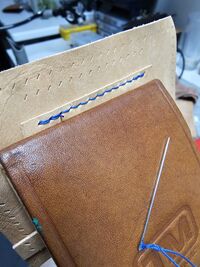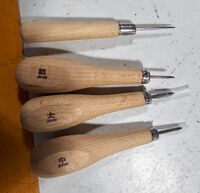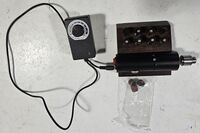Leather Working: Difference between revisions
Jump to navigation
Jump to search
en>Justinf (→Photos) |
en>Justinf (→Photos) |
||
| Line 30: | Line 30: | ||
[[File:Stitchingclamp.jpg|200px|thumb|left|Example of stitching clamp in use.]] | [[File:Stitchingclamp.jpg|200px|thumb|left|Example of stitching clamp in use.]] | ||
[[File:Awls.jpg|200px|thumb|Top: scratch awl. Bottom 3: various sizes of saddler's awl.]] | |||
[[File:Burnisher.jpg|200px|thumb|Automatic burnisher tool + attachments for different thickness projects. Can also be used with sanding drums.]] | |||
Revision as of 05:34, 30 July 2023
Justin F. Donated leather working tools. I'm capturing a partial list of what was in this kit.
Tools
- Hollow punch set. Useful to punch round holes, such as to install buttons or rivets. There is a small hex key to tighten the screw which holds the interchangeable pieces in place.
- Edge slicker/burnisher tool + attachments. Used to burnish an edge for protection and aesthetics.
- Diamond chisels. Used to punch holes through one or more pieces prior to stitching.
- Stitching groover. As a matter of preference, it can be used to create a grooved stitch line. The stitches sitting in the groove will be less prone to abrading with use. More common practice is to mark the stitch line with a scratch awl before punching/stitching.
- Stitching awls. For one-off stitching holes and when a hole wasn't punched all the way through by stitching chisels.
- Scratch awl. Useful at various stages of a project. Particularly useful when starting a project for marking a pattern onto a piece of leather prior to cutting the components out.
- Edge bevelers. Used to bevel an edge in order to prevent fraying and maintain a professional appearance.
- Skivers (Tandy Super Skiver, safety skiver). These are used to thin a piece of leather. Most commonly, this will be useful to cut down bulk at an edge where multiple pieces are stitched together.
- Stitching clamps (2). This tool holds a project so it can be stitched with both hands.
- Honing guide. Block of red wood with different guides for sharpening different tools. Sandpaper placed on guide before tool is dragged along it.
- Thickness gauge. Used to measure the thickness of leather.
- Rivet setter. Used to set copper rivets.
- Edge creaser. Used to place a crease along the edge of a project for aesthetic value.
- Thread snipper.
Supplies
- Gum tragacanth. Edge finishing product. Used before beeswax.
- Beeswax. Edge finishing, etc.
- Leather adhesive (Eco-Flow Leather Weld). Two pieces can be glued together at the edge before stitching.
- Waxed threads. This is fairly heavy-duty thread and not ideal for all projects.
- Saddler's needles (John James #4). A versatile size of the most recommended saddler's needle for stitching leather (note holes must be punched beforehand).
- Blades for safety skivers.
- Sand paper for honing guide. Use lower number grits first, progressing to higher numbers.
- Honing compounds (yellow, green). Used to sharpen tools, such as edge bevelers. Can be loaded onto a piece of thread which is pulled through the groove on an edge beveler to sharpen.
Photos


